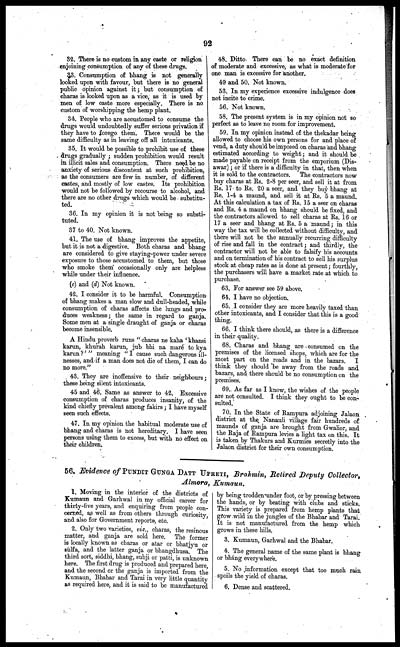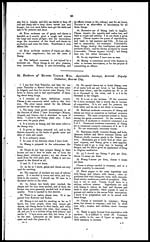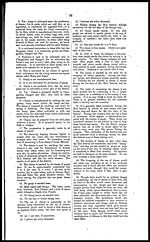Medicine - Drugs > Report of the Indian Hemp Drugs Commission, 1894-1895 > Volume V
(112) Page 92
Download files
Individual page:
Thumbnail gallery: Grid view | List view

92
32. There is no custom in any caste or religion
enjoining consumption of any of these drugs.
33. Consumption of bhang is not generally
looked upon with favour, but there is no general
public opinion against it; but consumption of
charas is looked upon as a vice, as it is used by
men of low caste more especially. There is no
custom of worshipping the hemp plant.
34. People who are accustomed to consume the
drugs would undoubtedly suffer serious privation if
they have to forego them. There would be the
same difficulty as in leaving off all intoxicants.
35. It would be possible to prohibit use of these
drugs gradually ; sudden prohibition would result
in illicit sales and consumption. There need be no
anxiety of serious discontent at such prohibition,
as the consumers are few in number, of different
castes, and mostly of low castes. Its prohibition
would not be followed by recourse to alcohol, and
there are no other drugs which would be substitu-
ted.
36. In my opinion it is not being so substi-
tuted.
37 to 40. Not known.
41. The use of bhang improves the appetite,
but it is not a digestive. Both charas and bhang
are considered to give staying-power under severe
exposure to those accustomed to them, but those
who smoke them occasionally only are helpless
while under their influence.
(c) and (d) Not known.
42. I consider it to be harmful. Consumption
of bhang makes a man slow and dull-headed, while
consumption of charas affects the lungs and pro-
duces weakness; the same in regard to ganja.
Some men at a single draught of ganja or charas
become insensible.
A Hindu proverb runs "charas ne kaha 'khansi
karun, khurah karun, jub bhi na maré to kya
karun?'" meaning "I cause such dangerous ill-
nesses, and if a man does not die of them, I can do
no more."
43. They are inoffensive to their neighbours;
these being silent intoxicants.
45 and 46. Same as answer to 42. Excessive
consumption of charas produces insanity, of the
kind chiefly prevalent among fakirs; I have myself
seen such effects.
47. In my opinion the habitual moderate use of
bhang and charas is not hereditary. I have seen
persons using them to excess, but with no effect of
48. Ditto There can be no exact definition
of moderate and excessive, as what is moderate for
one man is excessive for another.
49 and 50. Not known.
53. In my experience excessive indulgence does
not incite to crime.
56. Not known.
58. The present system is in my opinion not so
perfect as to leave no room for improvement.
59. In my opinion instead of the thekadar being
allowed to choose his own persons for and place of
vend, a duty should be imposed on charas and bhang
estimated according to weight; and it should be
made payable on receipt from the emporium (Dis-
awar); or if there is a difficulty in that, then when
it is sold to the contractors. The contractors now
buy charas at Rs. 2-8 per seer, and sell it at from
Rs. 17 to Rs. 20 a seer, and they buy bhang at
Re. 1-4 a maund, and sell it at Rs. 5 a maund.
At this calculation a tax of Rs. 15 a seer on charas
and Rs. 4 a maund on bhang should be fixed, and
the contractors allowed to sell charas at Rs. 16 or
17 a seer and bhang at Rs. 5 a maund; in this
way the tax will be collected without difficulty, and
there will not be the annually recurring difficulty
of rise and fall in the contract; and thirdly, the
contractor will not be able to falsify his accounts
and on termination of his contract to sell his surplus
stock at cheap rates as is done at present; fourthly,
the purchasers will have a market rate at which to
purchase.
63. For answer see 59 above.
64. I have no objection.
65. I consider they are more heavily taxed than
other intoxicants, and I consider that this is a good
thing.
66. I think there should, as there is a difference
in their quality.
68. Charas and bhang are consumed on the
premises of the licensed shops, which are for the
most part on the roads and in the bazars. I
think they should be away from the roads and
bazars, and there should be no consumption on the
premises.
69. As far as I know, the wishes of the people
are not consulted. I think they ought to be con-
sulted.
70. In the State of Rampura adjoining Jalaon
district at the Nanauli village fair hundreds of
maunds of ganja are brought from Gwalior, and
the Raja of Rampura levies a light tax on this. It
is taken by Thakurs and Kurmies secretly into the
Jalaon district for their own consumption.
56. Evidence of PUNDIT GUNGA DATT UPRETI, Brahmin, Retired Deputy Collector,
Almora, Kumaun.
1. Moving in the interior of the districts of
Kumaun and Garhwal in my official career for
thirty-live years, and enquiring from people con-
cerned, as well as from others through curiosity,
and also for Government reports, etc.
2. Only two varieties, viz., charas, the resinous
matter, and ganja are sold here. The former
is locally known as charas or atar or bhatjyu or
sulfa, and the latter ganja or bhaugdhusa. The
third sort, siddhi, bhang, subji or patti, is unknown
here. The first drug is produced and prepared here,
and the second or the ganja is imported from the
Kumaun, Bhabar and Tarai in very little quantity
as required here, and it is said to be manufactured
by being trodden under foot, or by pressing between
the hands, or by beating with clubs and sticks.
This variety is prepared from hemp plants that
grow wild in the jungles of the Bhabar and Tarai.
It is not manufactured from the hemp which
grows in these hills.
3. Kumaun, Garhwal and the Bhabar.
4. The general name of the same plant is bhang
or bháng everywhere.
5. No information except that too much rain
spoils the yield of charas.
6. Dense and scattered.
Set display mode to: Large image | Zoom image | Transcription
Images and transcriptions on this page, including medium image downloads, may be used under the Creative Commons Attribution 4.0 International Licence unless otherwise stated. ![]()
| India Papers > Medicine - Drugs > Report of the Indian Hemp Drugs Commission, 1894-1895 > Volume V > (112) Page 92 |
|---|
| Permanent URL | https://digital.nls.uk/75121155 |
|---|
| Description | Volume 5: Evidence of witnesses from North-Western Provinces and Oudh and Punjab. Answers from witnesses in North-Western Provinces, Oudh and Punjab about cultivation and growth of hemp, preparation or manufacture, trade, consumption or use, effects, administration - taxation and control. |
|---|---|
| Attribution and copyright: |
|




